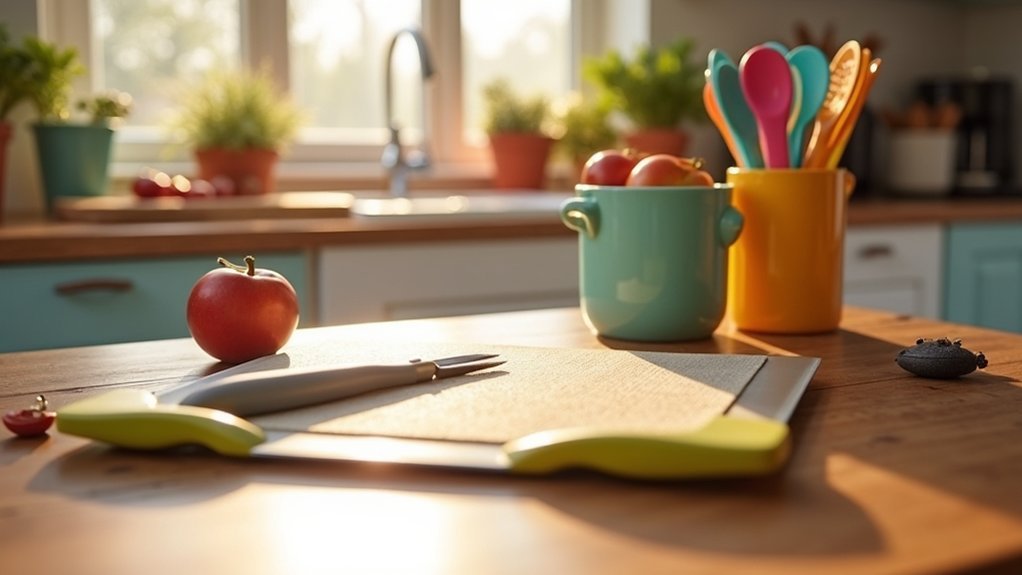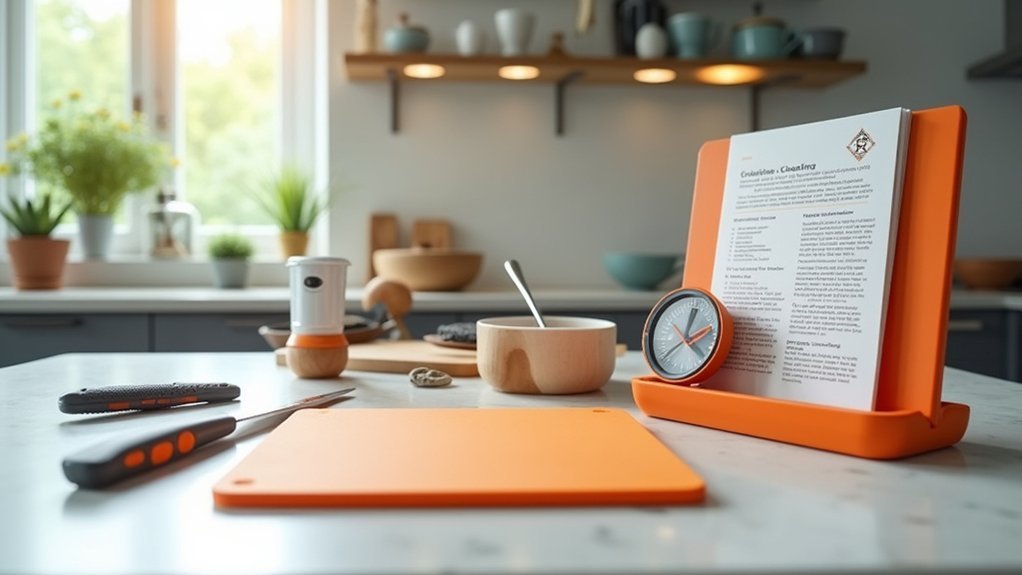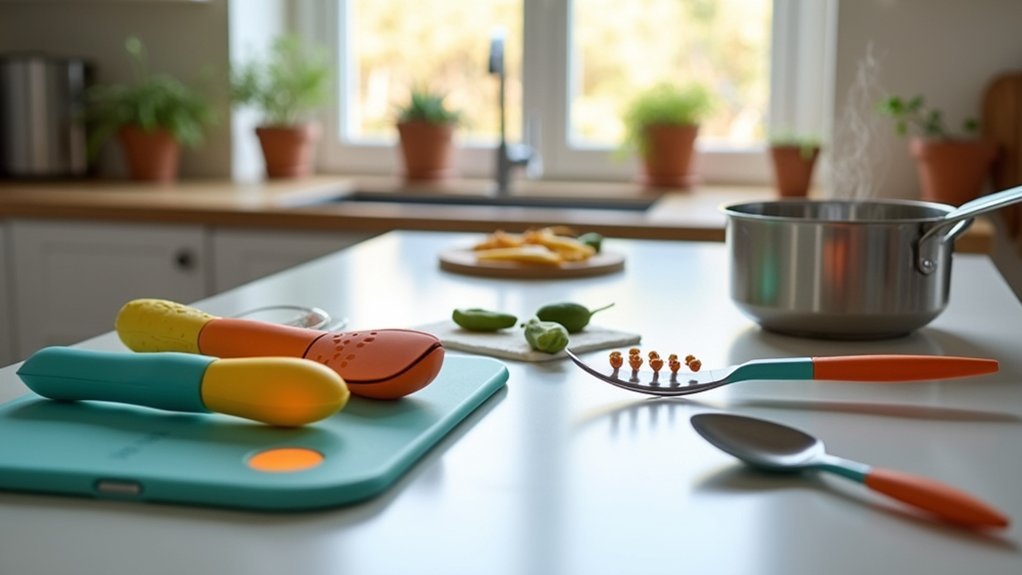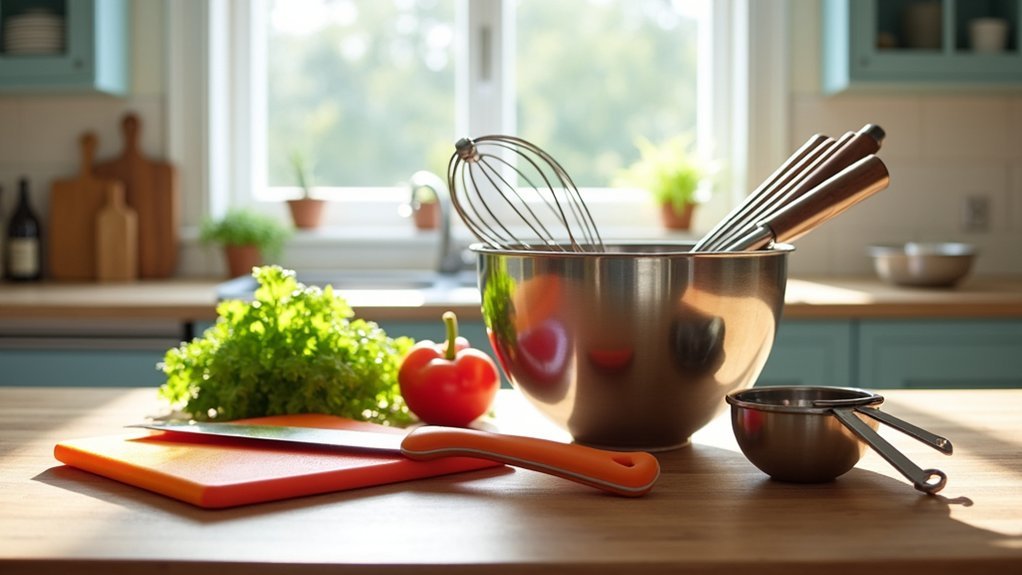For cognitive challenges in the kitchen, consider these five essential tools: adaptive utensils with built-up handles for easier gripping, smart cooking devices with AI assistance and reminders, the COOK web application offering personalized recipe adaptation, visual recipe guides with picture-based instructions, and safety-first kitchen tools featuring automatic monitoring systems. These innovations help maintain independence while reducing cognitive load and preventing accidents. Discover how these accessible solutions can transform meal preparation while keeping your kitchen safe.
Adaptive Utensils That Revolutionize Kitchen Independence

While many take everyday kitchen tasks for granted, those facing cognitive or physical challenges often struggle with standard utensils.
Built-up handles offer an easy solution, with cylindrical foam or silicone grips that accommodate weakened hand strength and limited mobility.
Enlarged foam grips transform ordinary utensils into adaptive tools, empowering those with limited dexterity to maintain mealtime independence.
For those with tremors, weighted utensils provide stability and control, especially beneficial for Parkinson’s patients. They’re available in various weights to match individual needs. Youth Weighted Utensils specifically help children develop motor skills while reducing tremors during mealtimes.
When grip is severely limited, universal cuff holders secure utensils to hands, eliminating the need for fine motor skills.
Meanwhile, curved and angled designs reduce wrist strain while improving food pickup.
Don’t overlook color-contrasting dining sets, which can increase food intake by 25% for those with dementia or vision impairments by enhancing visual recognition of meals.
Smart Cooking Devices With Cognitive Support Features
Because traditional cooking requires complex mental processes, smart kitchen devices now incorporate revolutionary cognitive support features that transform independence for those with memory or processing challenges.
AI-powered assistants like GE’s SmartHQ offer measurement conversions and ingredient substitutions, reducing cognitive load during meal preparation.
You’ll find systems like COOK that provide timely reminders, optimize your cooking environment, and adapt recipes to your specific abilities.
Smart probes deliver real-time temperature monitoring with helpful notifications, eliminating guesswork. These technologies integrate sensors that detect potential safety risks, such as forgotten burners.
Most devices feature tactile screens with simple interfaces, big labels, and visual aids. Voice-enabled technology, primarily through Alexa integration, allows for hands-free control of kitchen appliances, making operations simple for older adults with cognitive challenges.
The best systems divide cooking tasks based on your changing abilities, creating collaborative experiences where family members can participate according to their individual strengths.
COOK Assistive Technology: A Game-Changer for Memory Challenges

For individuals struggling with cognitive impairments, the COOK web application represents a transformative approach to kitchen independence. This tactile-screen technology combines a cognitive support module with a self-monitoring security system that connects directly to smart stoves.
You’ll benefit from personalized features like adapted recipes, reminders, and timers that reduce cognitive load by breaking cooking tasks into manageable steps. The system’s most impressive safety feature automatically turns off your stove if you leave the kitchen unexpectedly. The one-on-one training approach mirrors IATP’s successful methodology, ensuring users receive personalized guidance tailored to their specific challenges.
What sets COOK apart is its user-centered design—occupational therapists can configure the system to match your specific cognitive needs. This customization enables you to maintain kitchen autonomy while ensuring safety, making COOK particularly valuable if you’re an older adult wanting to preserve independence despite memory challenges.
Visual Recipe Guides and Picture-Based Cooking Systems
Visual recipes are accessible through various formats, including:
Visual cooking guides available as apps, cookbooks, online platforms, and printed materials—meeting diverse accessibility needs where traditional recipes fall short.
- Smartphone apps with audio and video prompts
- Picture-based cookbooks like “Look ‘n Cook”
- Free online platforms such as Accessible Chef
- Adaptable printed materials with enlarged text
You’ll find these guides particularly helpful as they use short sentences and simple vocabulary, typically at a 4.4 grade reading level.
They’re designed with your input to accommodate food sensitivities and preferences. Studies confirm that visual recipe systems considerably improve cooking independence for people with developmental disabilities and cognitive challenges. Visual recipes utilize task analysis to break down complex cooking processes into simpler, more manageable steps.
When cognitive challenges make traditional recipes difficult to follow, visual recipe guides offer a powerful alternative. These evidence-based tools break cooking tasks into manageable steps using images, borders, and color-coding for enhanced comprehension.
Safety-First Kitchen Tools With Automatic Monitoring

Beyond visual guides, the kitchen can become safer through intelligent monitoring systems that work continuously to prevent accidents and errors.
These tools are especially valuable if you’re managing cognitive challenges. Systems like ComplianceMate and E-Control offer real-time temperature alerts that don’t require constant attention. You’ll receive notifications when something needs your intervention, reducing the mental load of remembering to check appliances.
Many tools feature simple interfaces accessible via smartphones, allowing you to monitor your kitchen from anywhere. The IntelliSense™ system continuously tracks equipment temperatures, while automated data logging eliminates the need for manual record-keeping. The patented technology behind these systems provides advanced monitoring capabilities that enhance safety for users with cognitive challenges.
These safety tools redirect your focus from worrying about potential hazards to enjoying the cooking process, making the kitchen a less stressful environment.
Frequently Asked Questions
How Do I Assess Which Cognitive Cooking Tools Fit My Specific Needs?
To assess which cognitive cooking tools fit your specific needs, identify your main challenges, try tools with step-by-step guidance, evaluate interface simplicity, and consider your comfort with technology and home environment compatibility.
Are Insurance Companies Covering These Assistive Cooking Technologies?
Insurance coverage for assistive cooking technologies varies widely. You’ll need to verify with your specific insurer, obtain a medical necessity letter, and explore alternative funding if Medicare or private insurance denies coverage.
What Maintenance Do These Specialized Cooking Tools Require?
You’ll need to update software regularly, clean and inspect sensory-friendly equipment, backup data, and keep digital interfaces functioning. Don’t forget to organize tools to prevent confusion and check for wear and tear periodically.
Can These Tools Benefit People With Temporary Cognitive Impairments?
Yes, you’ll find these tools valuable for temporary cognitive impairments, like those after brain injury or illness. They’ll support your recovery by providing step-by-step guidance and compensating for short-term memory and executive function challenges.
How Do I Introduce These Tools Without Overwhelming Someone With Dementia?
Start with familiar, simple tools and introduce one at a time. You’ll want to pair them with well-known recipes, provide gentle guidance, and allow plenty of time for practice and adaptation.
In Summary
You’ve now discovered powerful tools that can transform your kitchen experience despite cognitive challenges. Whether you’re using adaptive utensils, smart devices, or visual guides, you’ll find cooking more accessible and enjoyable. These innovations don’t just make meal preparation safer—they restore independence and confidence. By incorporating these specialized tools into your routine, you’re taking important steps toward maintaining your culinary skills and nutritional well-being.





Leave a Reply